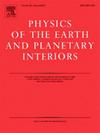Crustal shear-wave velocity structure of the Namche Barwa massif, eastern Himalayan Syntaxis, Tibet from ambient noise tomography
IF 1.9
3区 地球科学
Q2 GEOCHEMISTRY & GEOPHYSICS
引用次数: 0
Abstract
The eastern termination of the Himalayan orogeny, known as Namche Barwa, serves as a crucial natural laboratory for geodynamic studies of the Tibetan Plateau due to its distinctive geological and geomorphological characteristics. To enhance the understanding of regional tectonics, we deployed a dense array of 374 short-period geophones from June to July 2020 to record continuous waveforms. Using vertical-component data, we computed cross-correlation functions and extracted 13,466 Rayleigh wave phase-velocity dispersion curves for periods ranging from 0.8 to 8 s. We applied the direct surface wave tomography method to invert the three-dimensional shear-wave velocity structure at depths of 0–6 km in the region. Our results reveal that the shallow crustal velocity structure in this region exhibits significant lateral heterogeneity, reflecting the complexity of the geological units. Low-velocity anomalies are primarily observed near faults, including the Indus-Yarlung Suture Zone and the Jiali Fault, while a high-velocity anomaly is detected beneath the Namche Barwa massif. In combination with previous geophysical studies, including magnetotelluric (MT) and seismic imaging results, this high-velocity anomaly is speculated to reflect the intrusion of deep crustal material into the shallow crust. The spatial correlation between the velocity model and seismicity distribution suggests that earthquakes are closely associated with local stress conditions, velocity structure, and the presence of aqueous fluids and geothermal anomalies.

环境噪声层析成像研究青藏高原东喜马拉雅结南车巴尔瓦地块地壳横波速度结构
喜马拉雅造山带的东部终点南切巴尔瓦,由于其独特的地质和地貌特征,成为青藏高原地球动力学研究的重要天然实验室。为了加强对区域构造的认识,我们于2020年6月至7月部署了374个短周期检波器的密集阵列,以记录连续波形。利用垂向分量数据,计算相互关联函数,提取周期为0.8 ~ 8 s的Rayleigh波相速度频散曲线13466条。我们应用直接面波层析成像方法反演了该地区0 ~ 6 km深度的三维横波速度结构。结果表明,该区地壳速度结构具有明显的横向非均质性,反映了地质单元的复杂性。低速异常主要出现在断层附近,包括印度河-雅鲁藏布缝合带和嘉里断层,而高速异常主要出现在南切巴尔瓦地块下方。结合以往地球物理研究成果,包括大地电磁(MT)和地震成像结果,推测该高速异常反映了深部地壳物质侵入浅层地壳。速度模型与地震活动性分布的空间相关性表明,地震与局部应力条件、速度结构以及水流体和地热异常的存在密切相关。
本文章由计算机程序翻译,如有差异,请以英文原文为准。
求助全文
约1分钟内获得全文
求助全文
来源期刊

Physics of the Earth and Planetary Interiors
地学天文-地球化学与地球物理
CiteScore
5.00
自引率
4.30%
发文量
78
审稿时长
18.5 weeks
期刊介绍:
Launched in 1968 to fill the need for an international journal in the field of planetary physics, geodesy and geophysics, Physics of the Earth and Planetary Interiors has now grown to become important reading matter for all geophysicists. It is the only journal to be entirely devoted to the physical and chemical processes of planetary interiors.
Original research papers, review articles, short communications and book reviews are all published on a regular basis; and from time to time special issues of the journal are devoted to the publication of the proceedings of symposia and congresses which the editors feel will be of particular interest to the reader.
 求助内容:
求助内容: 应助结果提醒方式:
应助结果提醒方式:


